Physical Address
304 North Cardinal St.
Dorchester Center, MA 02124
The skin/fat envelope is tethered to the underlying musculoskeletal anatomy in zones of adherence. These include the spine, the sternum, the linea alba of the abdomen, the inguinal area, the suprapubic area and the area between the hip and lateral thigh fat.
Massive weight loss patients make up the majority of patients who undergo lower bodylift/belt lipectomy surgery. Second are females with a body mass index (BMI) in the range of 26–28. Third are normal weight females who wish a more dramatic improvement than an abdominoplasty alone.
Three factors affect patient presentation: the BMI, the fat deposition pattern, and the quality of the skin/fat envelope.
Bodylift/belt lipectomy procedures can be thought of as a circumferential wedge excision of the lower trunk. One end of the spectrum of procedures is the lower bodylift type II (Lockwood technique) and the other end is the belt lipectomy/central bodylift (Aly and Cram technique).
Patients presenting for this surgery require a complete medical assessment and a thorough physical examination.
In planning a bodylift/belt lipectomy, scar position can be approximated by simulating the tissue dynamics at the time of closure. Anteriorly, the inferior marks control the scar position, and posteriorly, the superior marks control the scar position.
The operative sequence usually involves anterior surgery first, followed by posterior surgery and closure.
Postoperative care requires hospital-level nursing with attention to patient positioning, early ambulation, fluid infusion, and pain control.
While major complications are possible, the commonest problem is seroma.
![]() Access video lecture content for this chapter online at Elsevier eBooks+
Access video lecture content for this chapter online at Elsevier eBooks+
Body contour deformities of the lower trunk can range from “anterior-only” to “circumferential” deformities. If the problems are restricted to isolated moderate lipodystrophy deposits, then liposuction may be the only treatment modality needed. Anteriorly, if skin laxity and/or abdominal wall weakness are encountered, then abdominoplasty techniques are needed to create the best contour. If the deformities involve skin and subcutaneous laxity circumferentially, then bodylift/belt lipectomy procedures are usually required to adequately address the issues. Thus, in looking at the treatment of a large range of patients presenting with lower truncal deformities, there is a transition from liposuction only, to “anterior-only” excisional procedures, to “circumferential” excisional procedures. This chapter addresses the circumferential lower truncal excisional procedures, most often referred to as “belt lipectomy” ( ![]() ).
).
It is important to have a clear understanding of the blood supply of the abdomen, when contemplating circumferential dermatolipectomy of the lower trunk. The anatomy of abdominal wall blood supply is reviewed elsewhere.
The subcutaneous abdominal fat is divided into superficial and deep layers by the superficial fascial system, which in this region of the body is called Scarpa's fascia. In thin patients, the two layers are fairly close to each other in thickness. In patients who have a high BMI, the superficial layer is often much thicker than the deep layer.
There are areas within the trunk where the skin/fat envelope is tethered to the underlying musculoskeletal anatomy, restricting either descent or elevation, which can occur with aging, weight fluctuation, or surgical manipulation. These areas are called “zones of adherence” and act like “hooks” for the skin/fat envelope to hang on to as it descends, especially after the skin has been stretched by excess weight and then deflated by weight loss ( Fig. 31.1 ). The zones of adherence overlying the spine and the sternum are both strong areas of adherence and are always present, while the zone of adherence overlying the midline linea alba of the abdomen is often weak to non-existent. There are strong zones of adherence overlying the inguinal region bilaterally that play an important role in controlling final scar position during bodylift/belt lipectomy. A more variable zone of adherence is located in the horizontal suprapubic area, which when present leads to a suprapubic crease. This zone of adherence, along with the inguinal zones of adherence, are responsible for a panniculus hanging over the mons pubis.
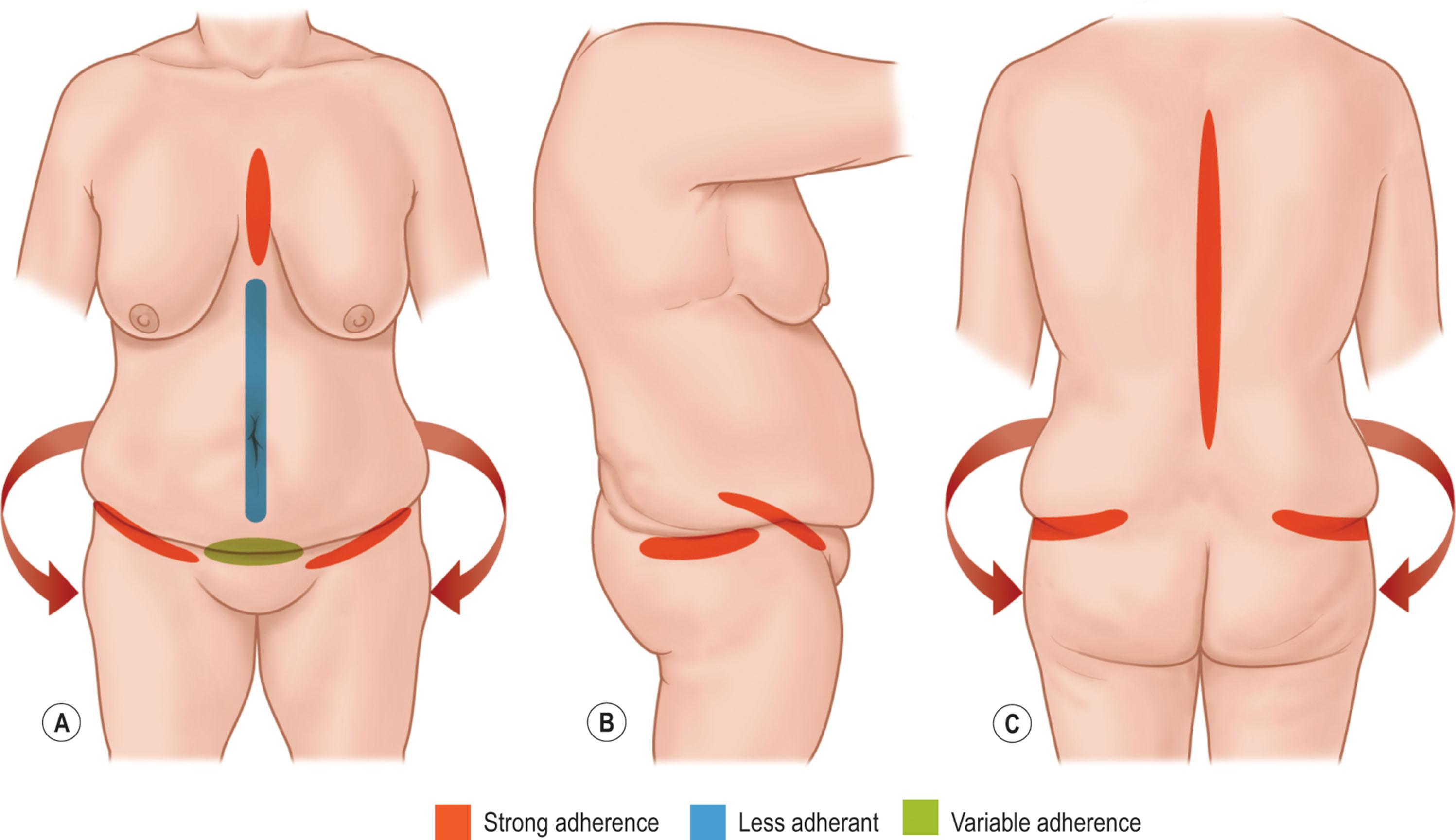
Another important zone of adherence is located between the hip and lateral thigh fat deposits and can prevent mobilization of tissues during surgery. In some procedures, such a “lower bodylift type II”, as described by Lockwood, this zone of adherence is intentionally disrupted to allow for significant elevation of the lateral thighs.
There are three groups of patients that can potentially benefit from bodylift/belt lipectomy. Although all of these groups will share some of the same indications and principles in design of the operations, they differ and should be considered here.
Abdominal dermatolipectomy/abdominoplasty has a long history, which is covered elsewhere in this book. Although there were scattered reports of circumferential dermatolipectomy in the literature in the twentieth century, they were few and that type of surgery was performed by very few surgeons. Although bariatric surgery was pioneered in the 1960s and 1970s by Mason, from the University of Iowa, it did not become popular until around the turn of the century. Around the year 2000, bariatric surgery experienced a boom, which has led to the onslaught of a new group of patients, collectively referred to as “massive weight loss patients” (MWL patients). Because of the circumferential nature of this group's deformities, circumferential dermatolipectomy is becoming a mainstream operation in plastic surgery. This chapter discusses circumferential dermatolipectomy in general, but especially in the MWL patient.
MWL patients make up the majority of patients who undergo bodylift/belt lipectomy. The lower trunk of MWL patients can be thought of as a balloon. As patients gain weight and then lose it, the balloon is initially stretched by the weight gain then deflated as weight loss ensues. Like a balloon that has been inflated for a long time, the intrinsic elasticity of the skin is irreversibly altered during this process, leading to redundant lax skin, which is almost always circumferential in nature. The usual pattern is of an inverted cone ( Fig. 31.2 ).
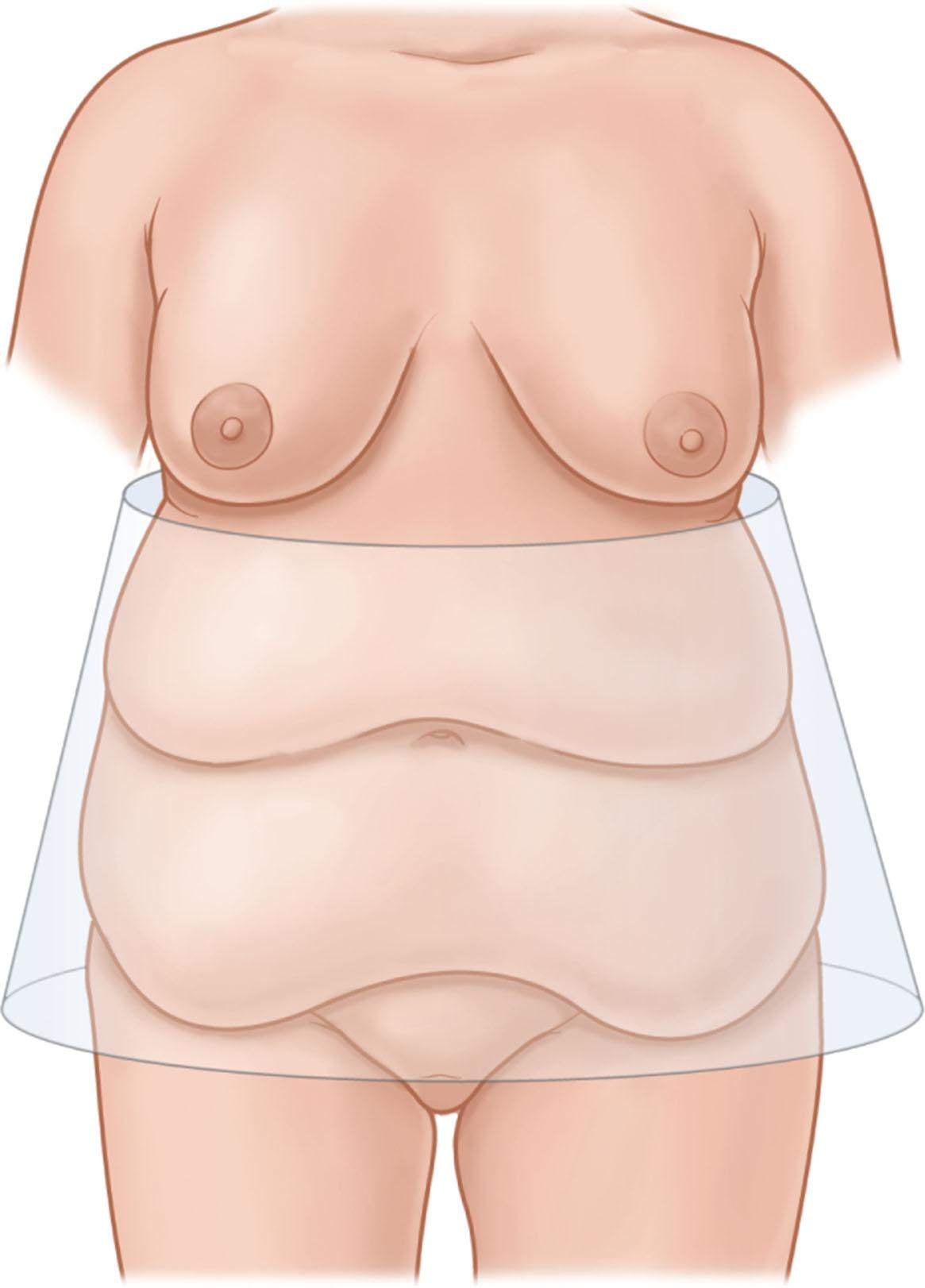
Women who are 20–30 pounds overweight (BMI range of 26–28) who have never lost any significant weight despite reasonable exercise and nutritional habits are the second group that can potentially benefit from bodylift/belt lipectomy. These patients present with lipodystrophy of the lower trunk that is circumferential in nature, which leads to generalized lack of definition of the lower trunk ( Fig. 31.3 ).
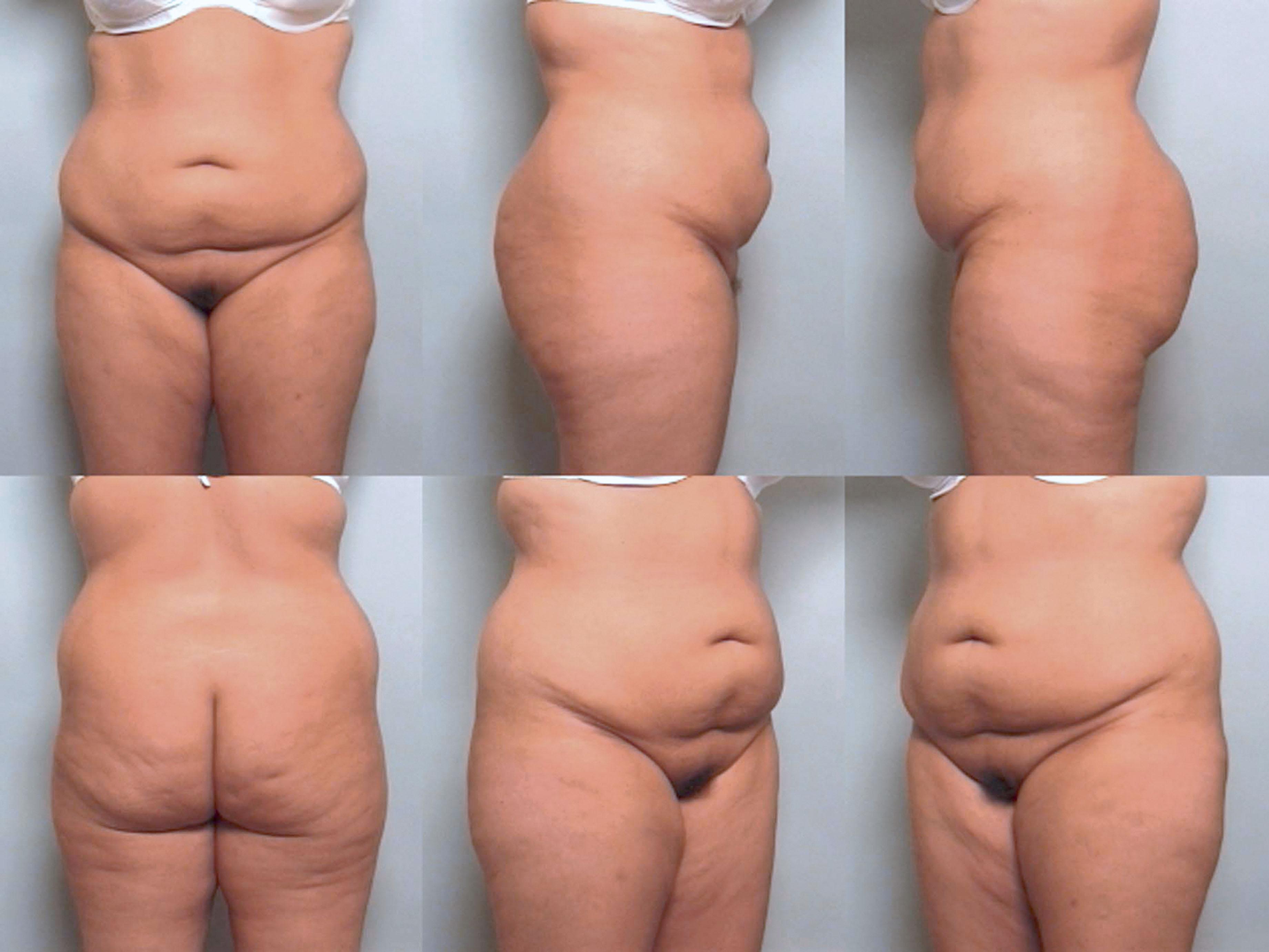
A third group that may benefit from bodylift/belt lipectomy are normal weight patients who ordinarily would be considered candidates for an “anterior-only” abdominoplasty but desire more dramatic improvements in lower truncal contour. These patients often desire a remarkable improvement in their anterior thighs, lateral thighs, buttocks, and lower back. In many similar patients, liposuction can improve all of these areas when combined with an abdominoplasty; however, if patients desire significant lifting and contour delineation, then a circumferential excisional procedure is required ( Fig. 31.4 ).
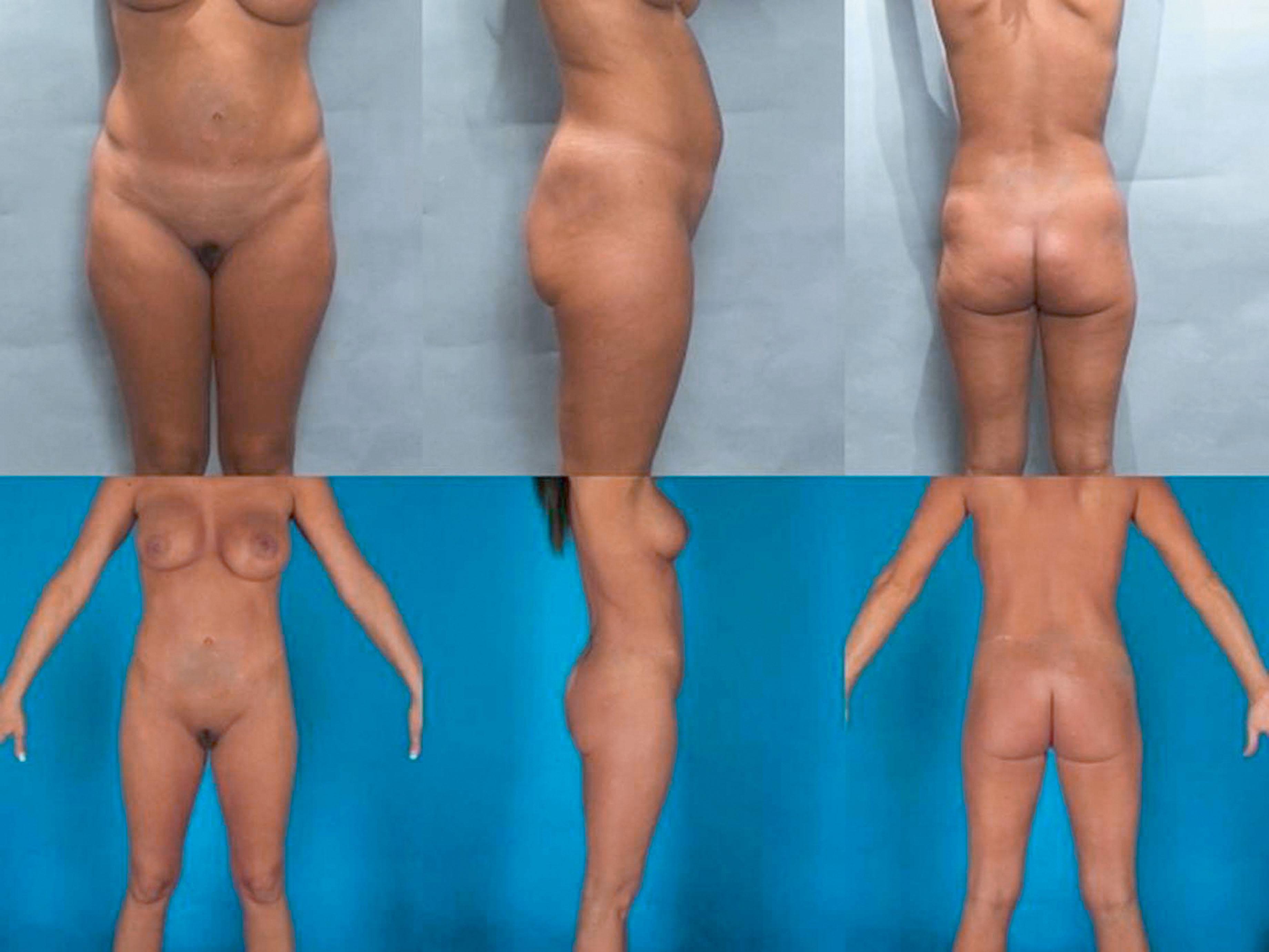
A subgroup of normal weight patients who can benefit from a bodylift/belt lipectomy is made up of older patients whose skin will not contract with liposuction due to skin laxity and will require the pull created by the circumferential excision ( Fig. 31.5 ).
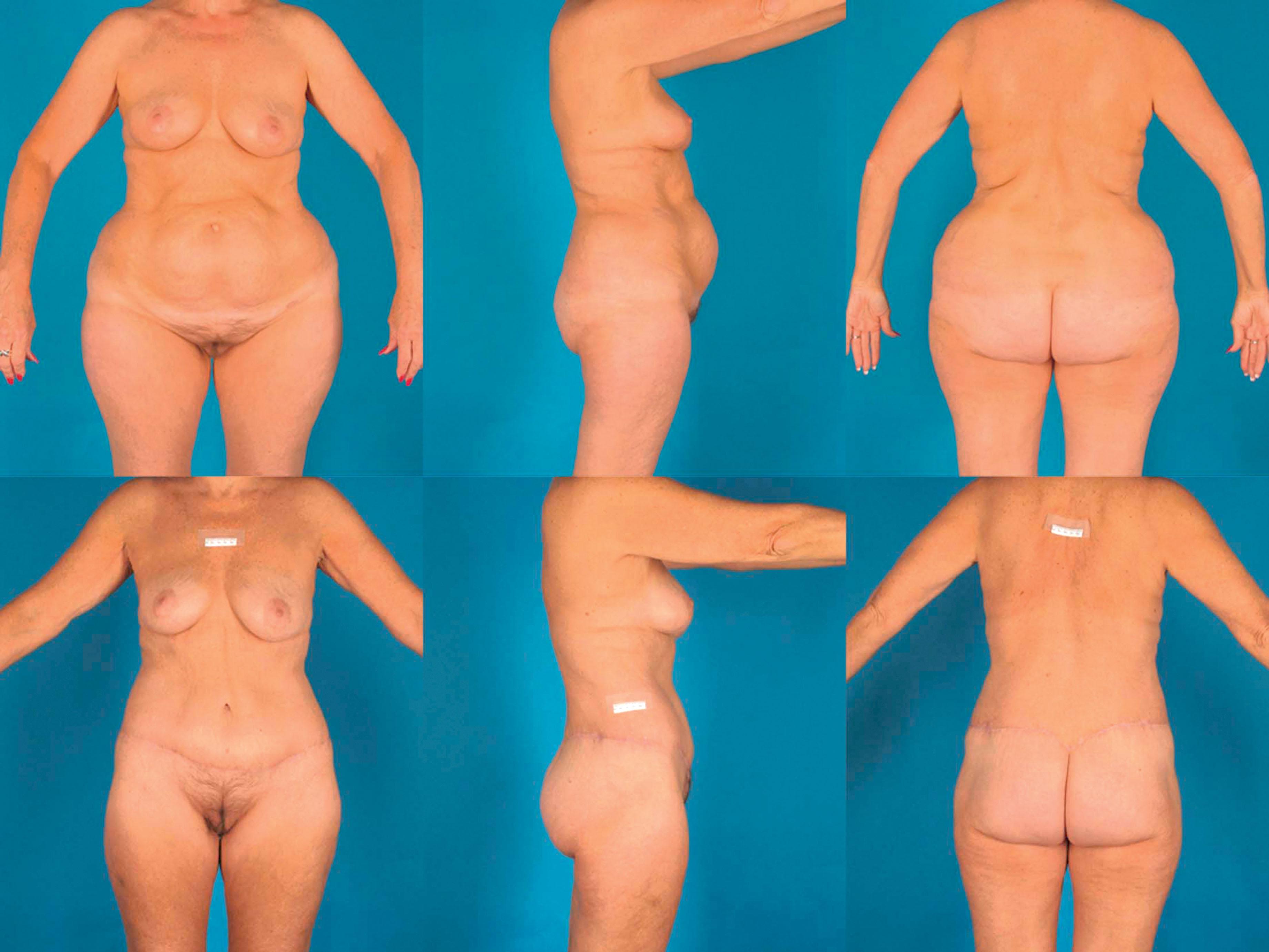
Most of the subsequent discussions will be centered around the MWL patients, and the other groups will be mentioned when appropriate. Although MWL patients are grouped together, they are quite variable in their presentation ( Fig. 31.6 ). Three factors seem to affect the presentation: the BMI at presentation, the fat deposition pattern, and the quality of the skin/fat envelope.
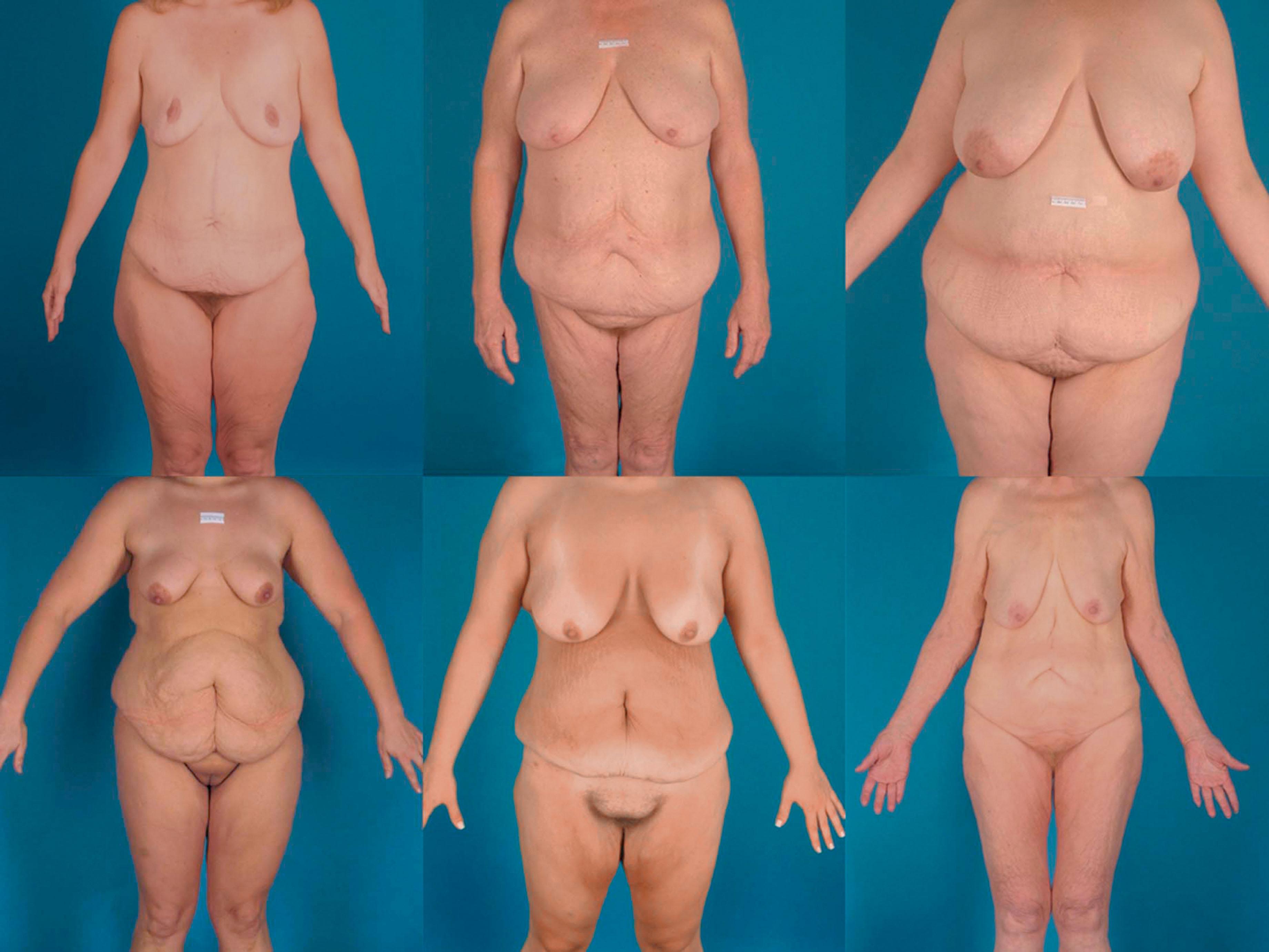
Massive weight loss patients will present to the plastic surgeons at different BMI levels (or different levels of deflation). For some, this level is still very high, BMIs of ≥35; for others, it may be intermediate, BMIs of 30–35; and for others, the BMI may drop to the mid- or low 20 s (see Fig. 31.6 ).
The type of deformity that an MWL patient presents with also depends on their particular fat deposition pattern. Humans are born with a genetically controlled pattern of fat deposition, as well as a fat loss pattern. For example, females generally tend to store fat in the extraperitoneal space, the lower abdomen, hips, and thighs – a pattern often referred to as “pear-shaped” ( Fig. 31.7 ). Males, on the other hand, tend to store fat more centrally, in what is often referred to as an “apple-shaped” configuration, where fat is deposited intraperitoneally and in the flanks (or “love handles”), and less fat is deposited in the thighs (see Fig. 31.7 ).
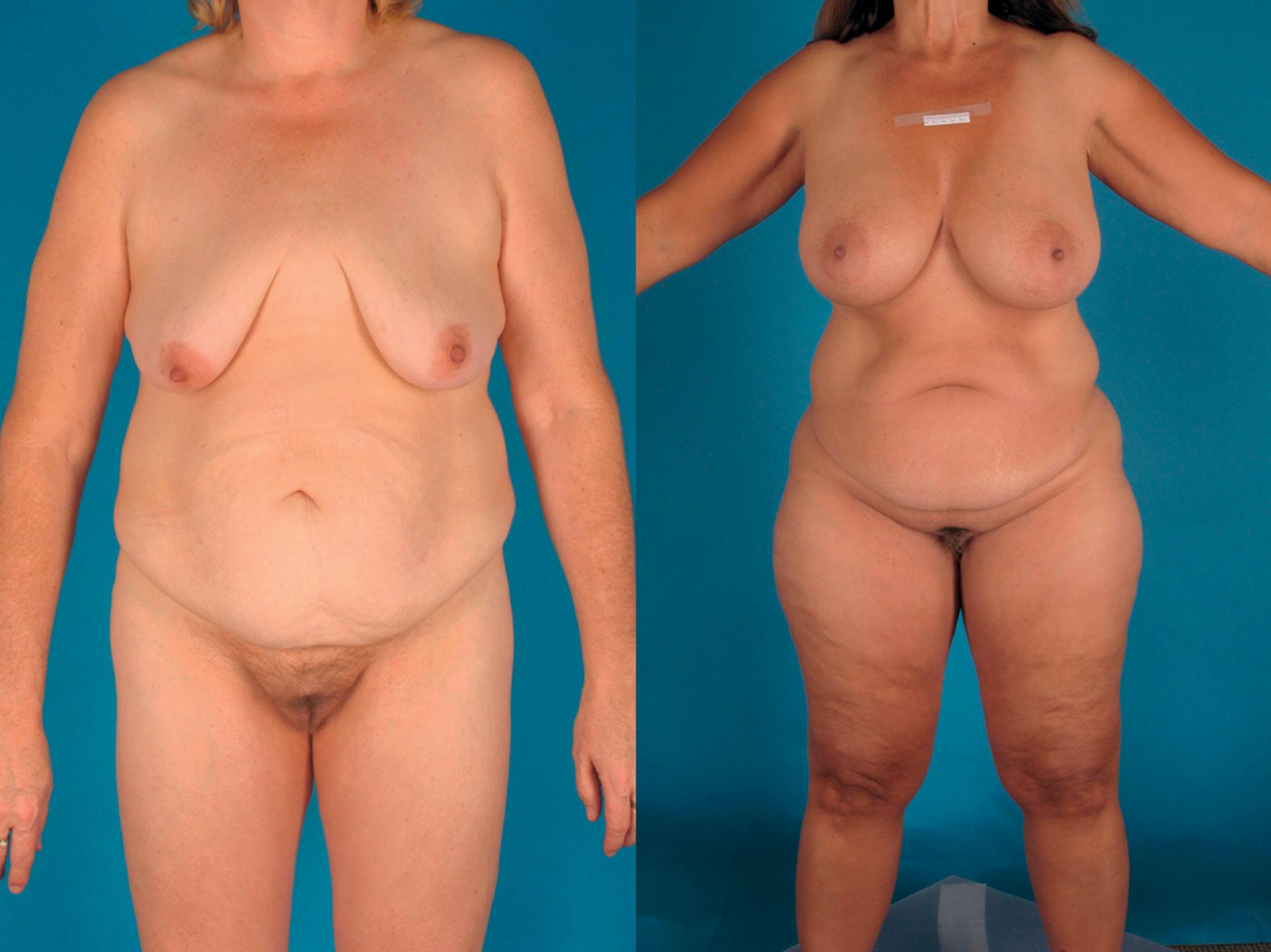
The skin/fat envelope is what a plastic surgeon operates on, and its intrinsic properties are especially important. Some patients present with very pliable and thin skin/fat envelopes, while others will present with very thick non-pliable tissues. A concept that the authors have found very helpful in examining these patients is the “translation of pull” ( Fig. 31.8 ). For example, when examining the patient prior to surgery, the lateral abdominal tissues are pinched, simulating the effects of the lateral abdominal resection of a bodylift/belt lipectomy on the distal thigh, which can be predictive of the final result with a certain degree of accuracy. If the pinch demonstrates very little translation of pull to these areas, as in the case of patients who present with high BMIs and thick, non-pliable skin/fat envelopes, this can be used to predict the final result. As a general rule, the greater the BMI drop, the more translation of pull will be present.
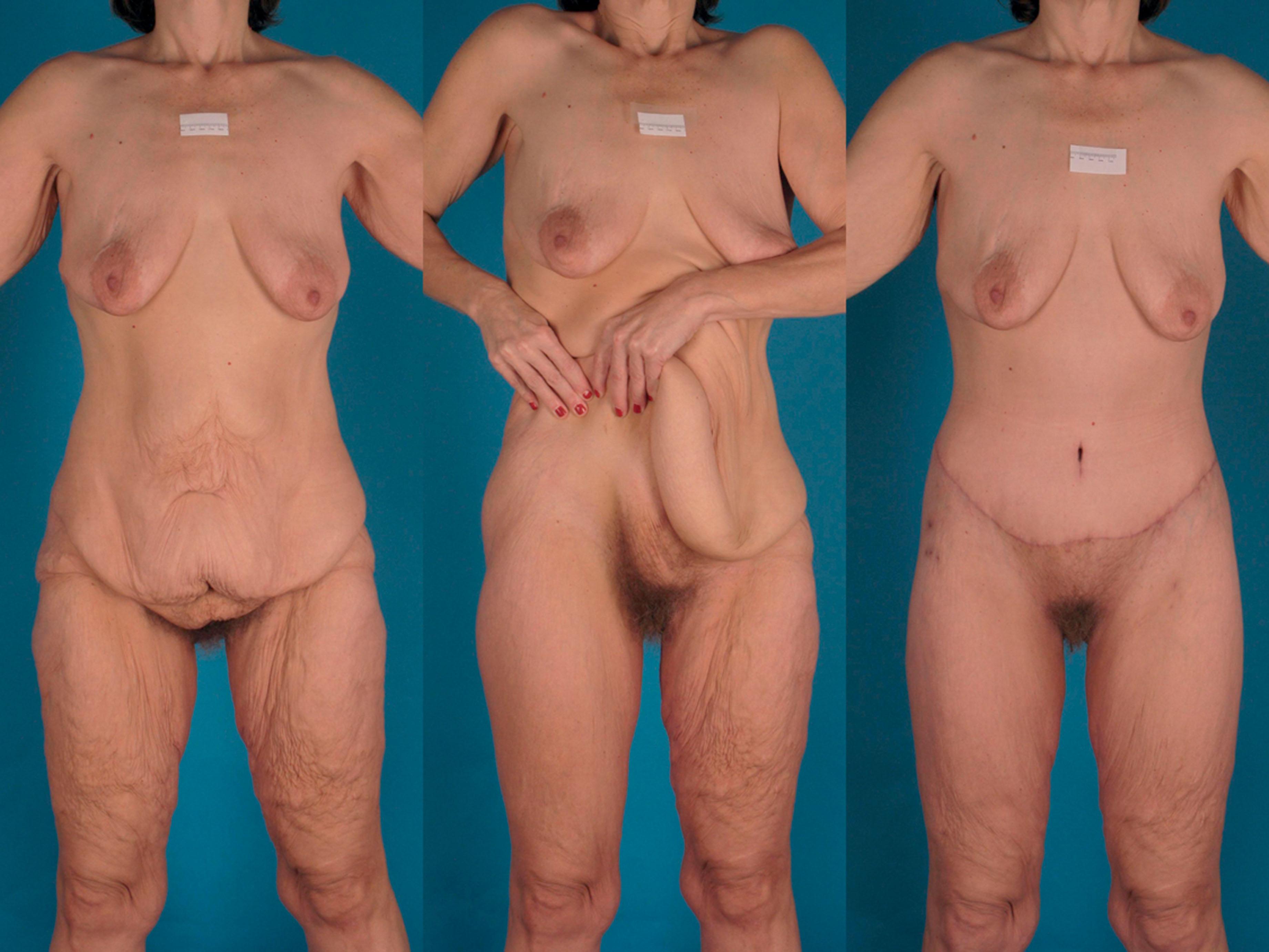
Almost all MWL patients present with a “hanging panniculus”. The size and shape of the panniculus will vary from one patient to the other based on their intrinsic fat deposition pattern ( Fig. 31.9 ). Almost every MWL patient will present with a “ptotic mons pubis”. The most obvious deformity is vertical excess with varying degrees of horizontal excess.
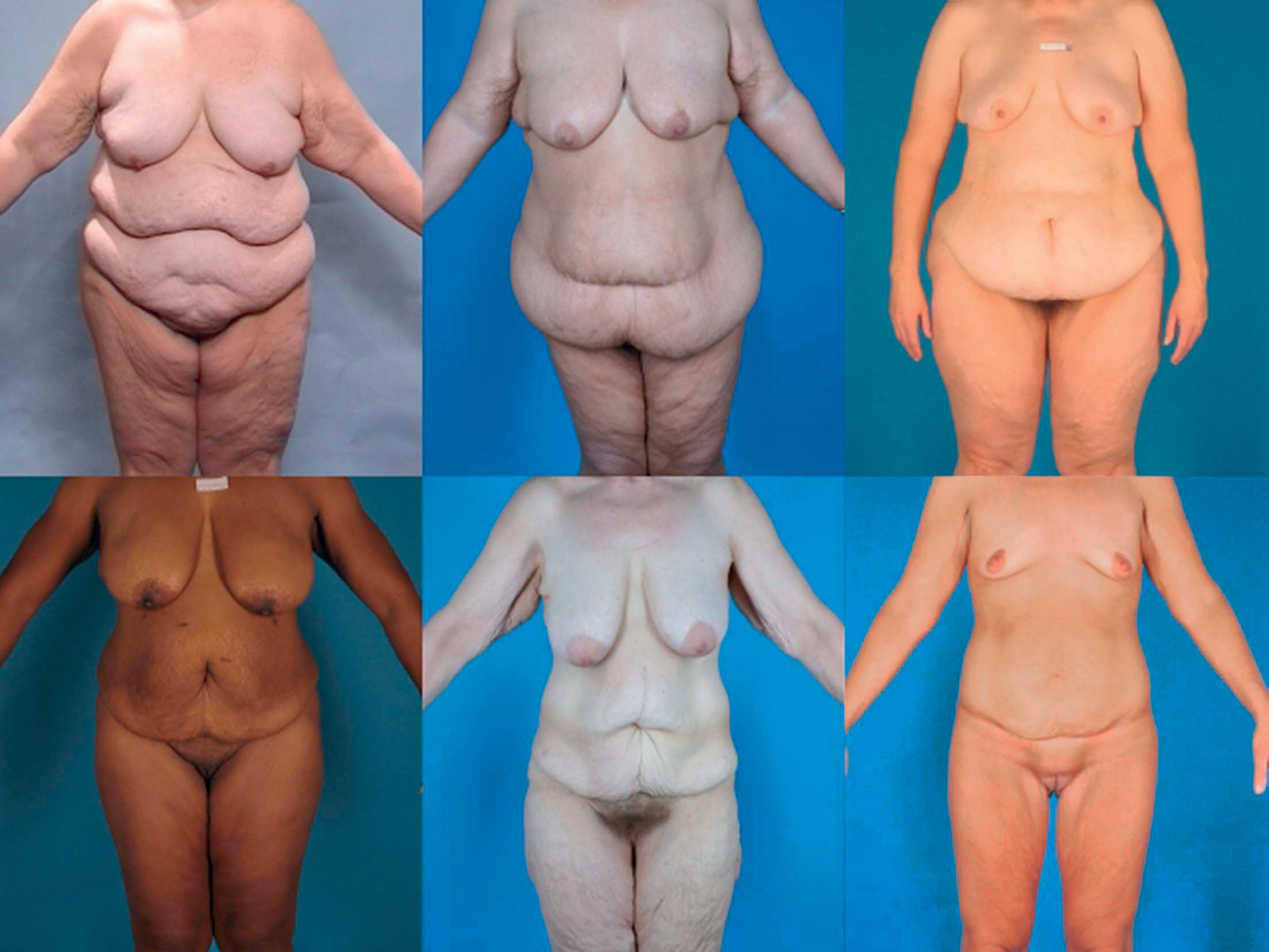
The waist, which is the narrowest aspect of the lower trunk between the ribs and the pelvic rim, can be blunted in many MWL patients by the hanging skin/soft tissue envelope as it drapes from the ribs to below the pelvic rim. The anterior and lateral thighs are usually ptotic. In patients who belong to the “20–30 pounds overweight” group and “the normal weight” group, the thighs are not as dramatically affected but are usually central to the need for a circumferential approach.
As with the thighs, the buttocks in the MWL patient are usually ptotic due to the effects of the weight gain/loss process. Many MWL patients also present with a lack of demarcation between the lower back and buttocks ( Fig. 31.10 ).
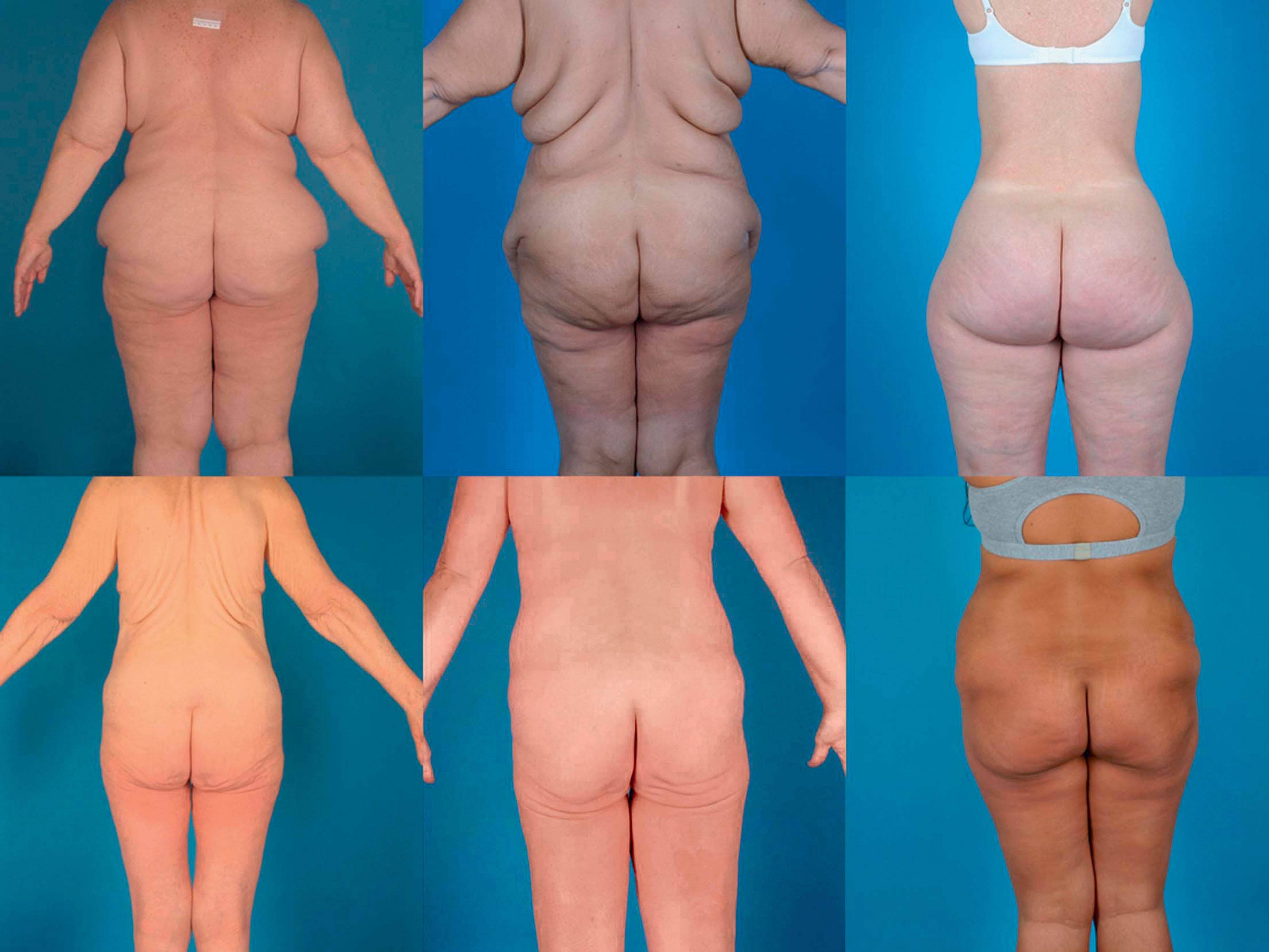
Many patients present with back rolls that are bothersome. Some back rolls are located in the lower back and those are generally amenable to improvement through bodylift/belt lipectomy. Superior back rolls, usually contiguous with breast rolls, or just below them, are not affected by bodylift/belt lipectomy procedures and must be addressed through upper bodylift procedures ( Fig. 31.11 ).
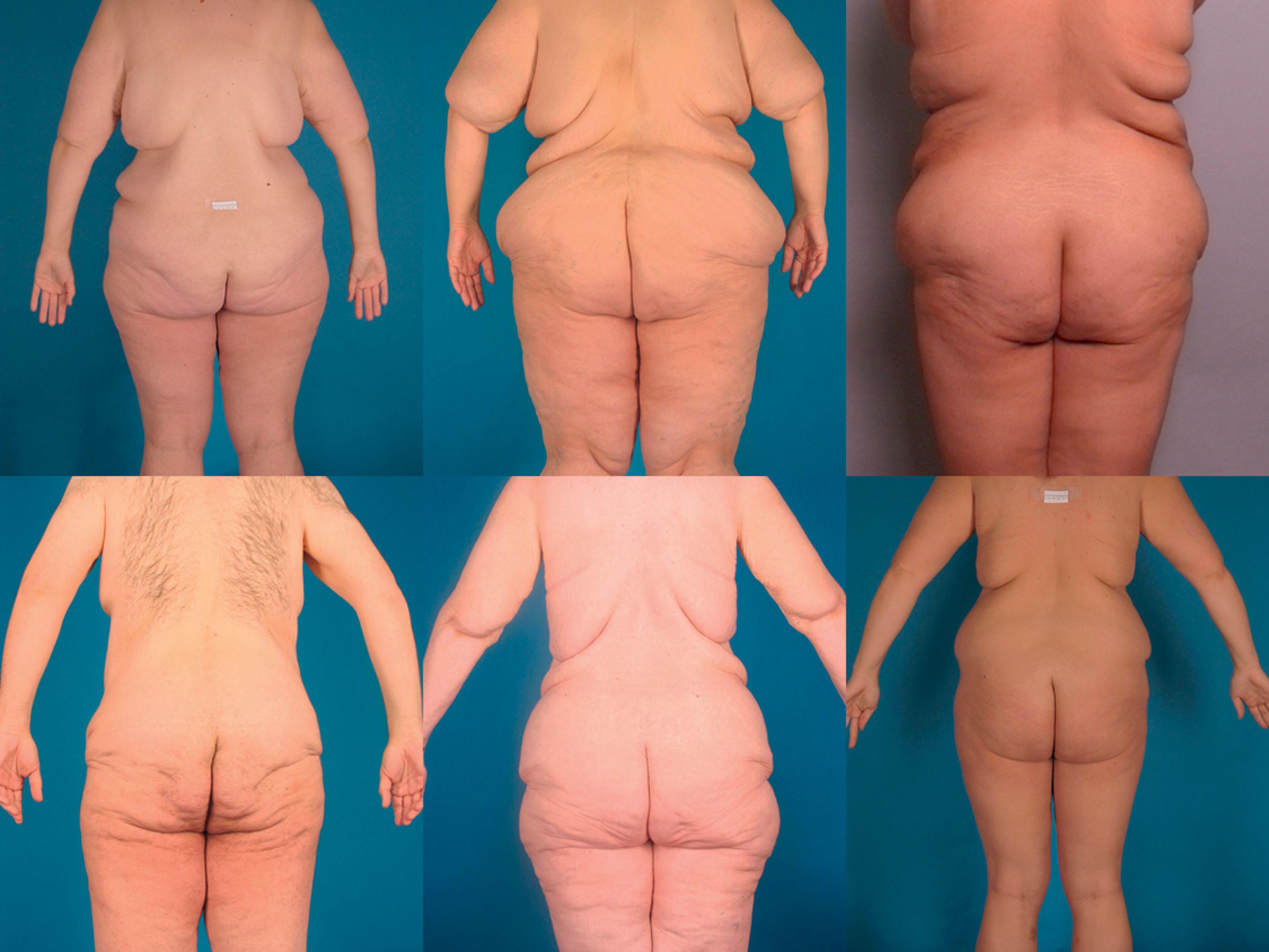
Although a “bodylift/belt lipectomy” can be thought of as a circumferential wedge excision of the lower trunk, there are variations of the procedure. We have categorized what we feel to be the ends of the spectrum of bodylifts and will go over the differences so that the reader may understand what each can accomplish. At one end is the “lower bodylift type II”, as originally described by Lockwood. At the other end, there is the “belt lipectomy”, as described by the authors, originally in Iowa. It is not the intent of the authors to suggest that one type of bodylift should be utilized over the other. Rather, it is hoped that the surgeon would be familiar with these techniques and be able to individualize the particular procedure to the needs of their particular patient.
In this type of bodylift, the overall circumferential wedge of resection is located lower onto the lower trunk. The procedure can be thought of as a truncal–thigh lift, not just a truncal lift. This technique is discussed in more detail in Chapter 32 . The bilateral zones of adherence located between the hip and trochanteric fat deposits are intentionally destroyed by discontinuous undermining and/or aggressive liposuction to allow the surgeon to lift the lateral and anterior thighs very aggressively.
The result of a lower bodylift type II is impressive in its elevation of the thighs, and it creates a fairly low scar that can be covered by most underwear or swimwear patterns ( Fig. 31.12 ). There are disadvantages and limitations of lower bodylift type II. Since the final scar is intentionally created below the widest aspect of the pelvic rim, the waist is not narrowed as much as it would if the final scar is created above. The authors call this the “sundress effect” because it pulls down the upper truncal tissues across the narrowest aspect, the waist, onto the widest aspect, the pelvic rim, leading to blunting of the waist, rather than narrowing. Anteriorly, the scar is considerably lower than the anterior superior iliac spine (ASIS), which poses no significant problem if the abdominal flap that is brought down to the level of the scar is thin. However, if the abdominal flap is thick, as in higher BMI patients, it will add to the prominence of the ASIS region, which should be flat, not convex. A disadvantage of a posterior low scar in a lower bodylift type II is that it violates the aesthetic unit principle. This is not problematic in patients who value hiding the scar within low underwear lines and do not require demarcation between the lower back and buttocks, i.e., a male patient. On the other hand, most female patients desire as much buttocks definition as possible and demarcation between the lower back and buttocks. Box 31.1 shows the main advantages and disadvantages of the lower bodylift type II.
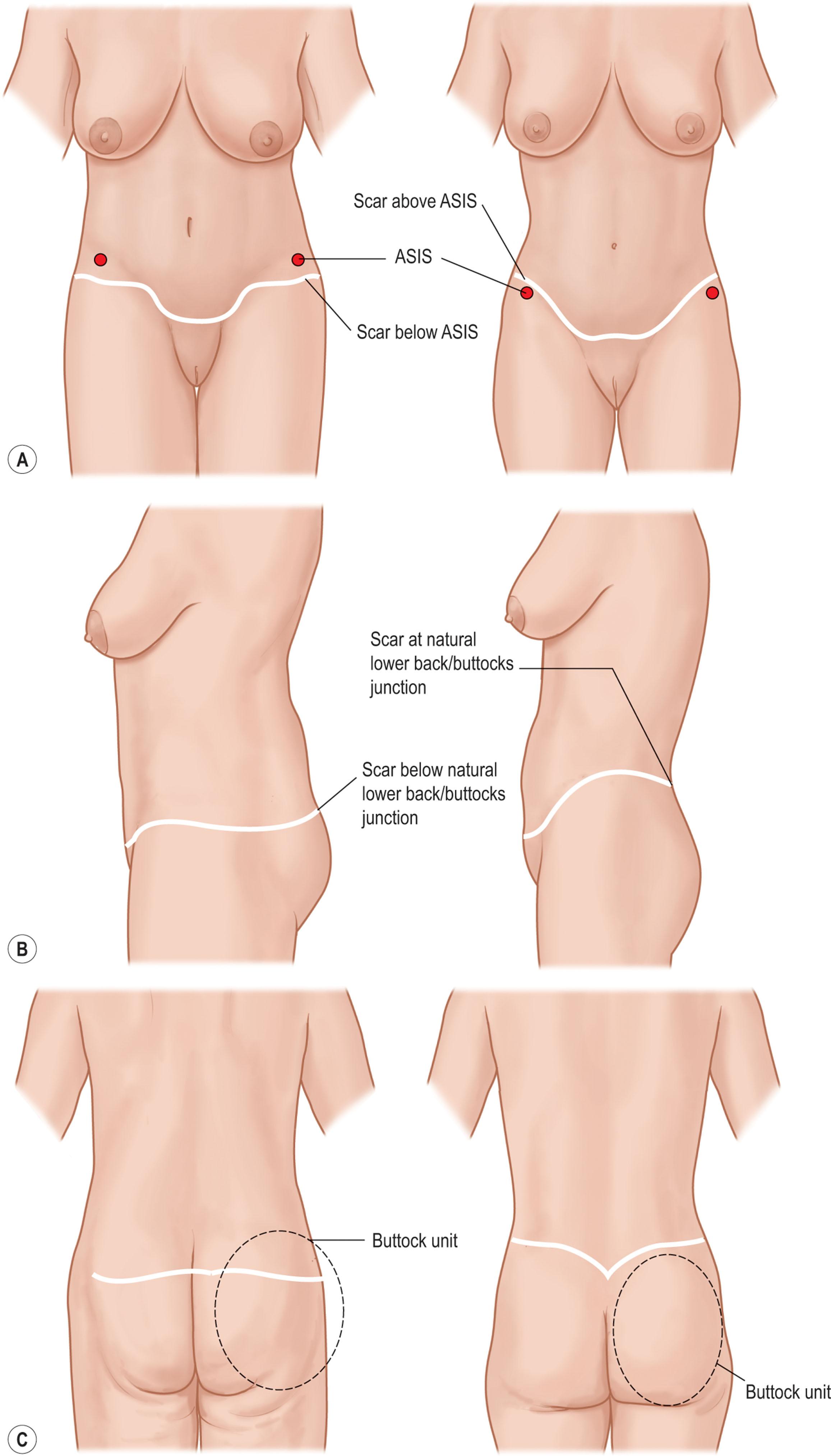
Lifts the trunk
Very aggressive thigh lift
Reduces the amount of surgery that may be subsequently needed on the thighs
Low scar position to be covered by low-lying swim/underwear
Become a Clinical Tree membership for Full access and enjoy Unlimited articles
If you are a member. Log in here